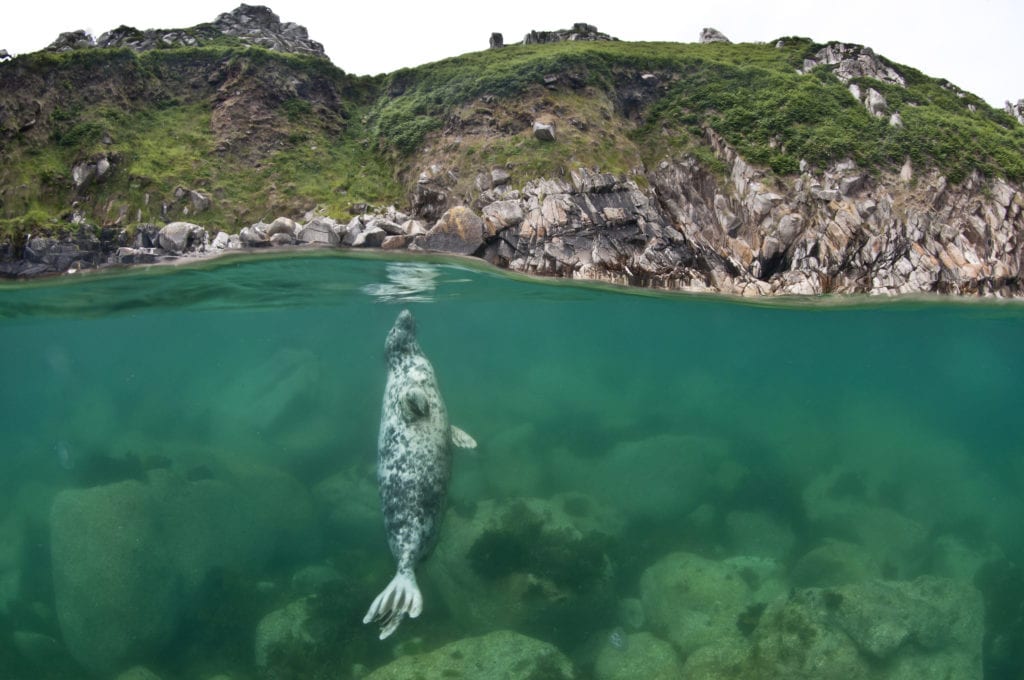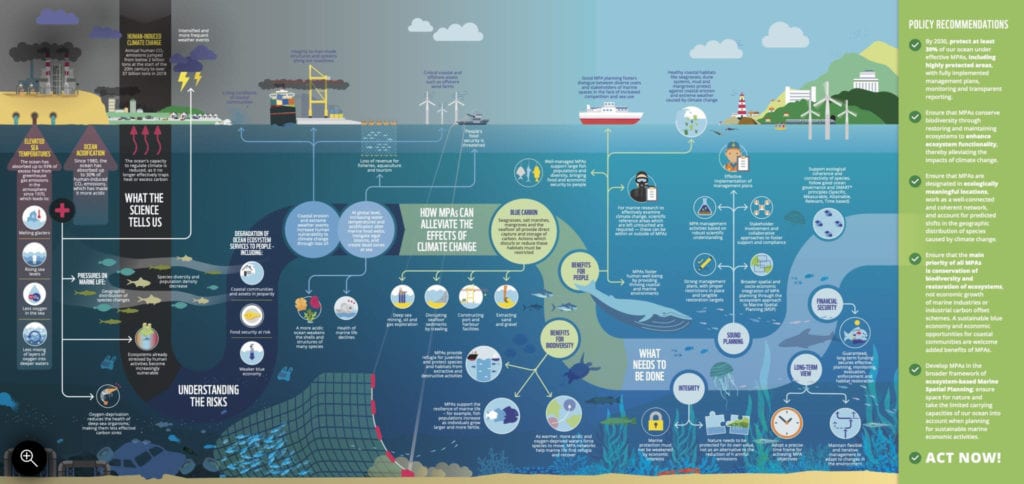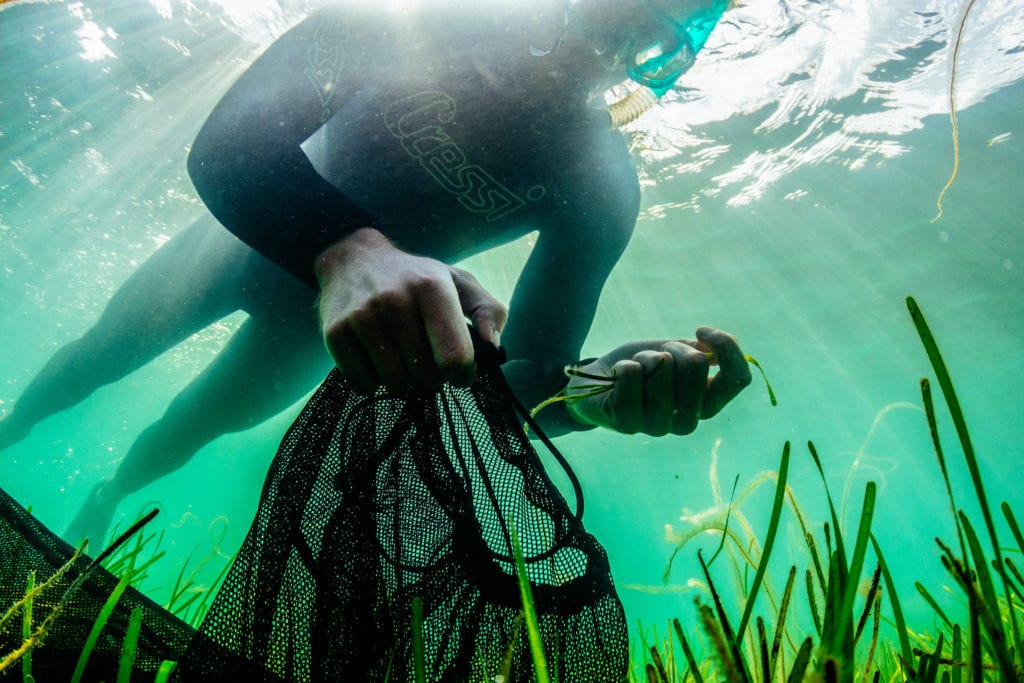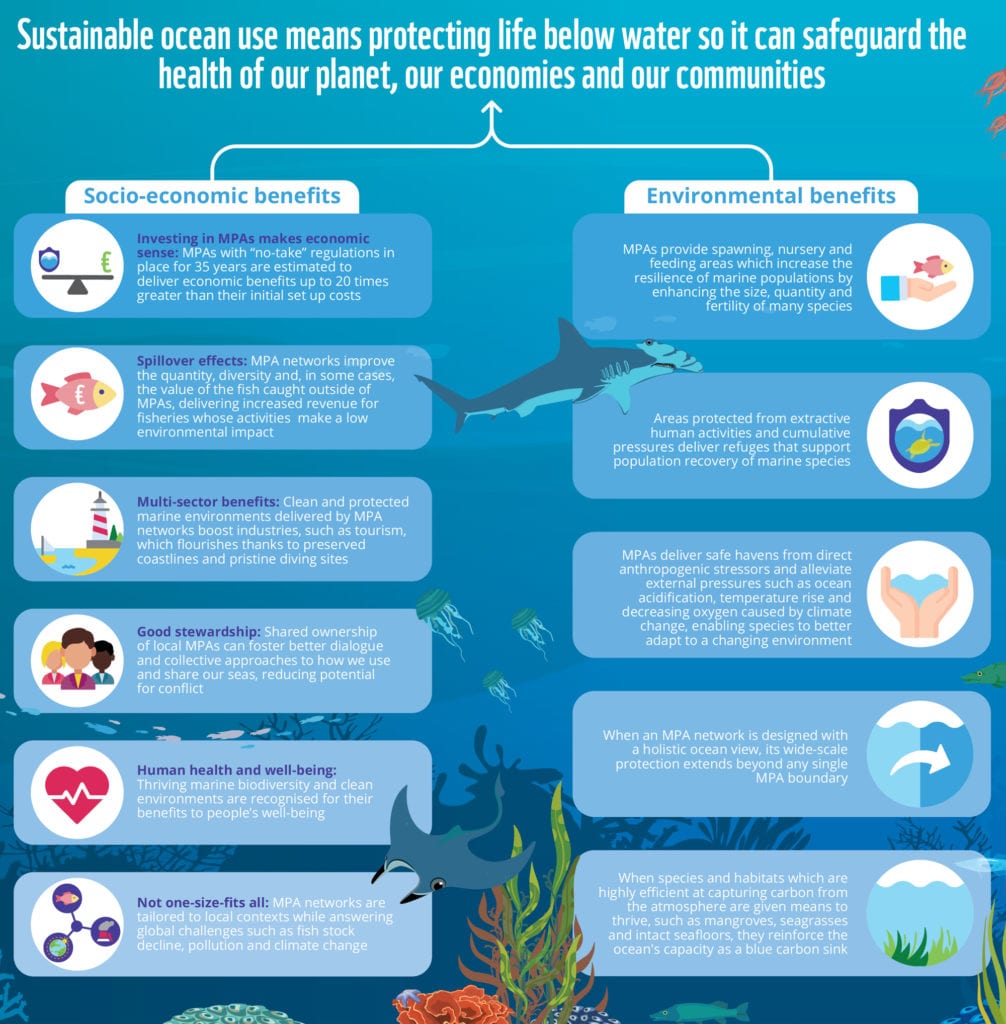Ocean Protection: Vital to Conservation and Climate Action
This autumn, the global policy agenda for our ocean kicks into high gear. As world leaders convene to agree on actions for emissions reductions and biodiversity restoration as part of a wider green recovery, the European Union (EU) must turn failed promises into tangible actions. A key tool which decision-makers already hold in hand is effective marine protection, as Marine Protected Areas (MPAs) are scientifically demonstrated to fight both the climate and biodiversity crises.
MPAs not only alleviate the negative effects of climate change on marine ecosystems, capture carbon, protect coastlines from erosion and reduce water acidification, they also constitute vital sanctuaries for many threatened species. In turn, they support our communities by contributing to food security and safeguarding the landscapes many of us call home. However, poor management and lack of sound planning of our seas continue to render the vast majority of MPAs to mere lines on a map. To ensure the resilience of our ocean in the face of unprecedented changes, it is imperative for the EU to deliver on its commitment to marine protection, setting a global precedent that will ultimately benefit both people and planet.
Climate: A crisis for our seas
A year ago, the 2019 IPCC’s report on the Ocean and Cryosphere highlighted the poor state of our ocean and alerted us to its compromised future. Since 1980, the ocean has absorbed up to 30% of human-induced carbon dioxide emissions, which acidifies our seas, making them inhospitable to life. Having taken in up to 93% of excess heat from greenhouse gas emissions in our atmosphere since 1970, the water is also getting warmer. The results include the melting glaciers and rising sea levels which fill our headlines, but also less visible consequences like reduced oxygen which suffocates marine life. As if this was not enough of a challenge, global overfishing combines with climate change to make things even worse for marine ecosystems, and we now face the disappearance of up to 15% of the global biomass of marine animals by 2100. The impacts on our societies would be extensive: fishery industries, for example, could lose up to a quarter of the fish needed to ensure populations remain large enough for us to continue harvesting seafood sustainably.
The ocean has absorbed up to 93% of excess heat from greenhouse gas emissions in our atmosphere since 1970.
Although the European Union (EU) likes to think of itself as a climate and biodiversity leader on the global stage, it’s easy to see that we’re falling short when we look at what’s happening in our own backyard. For generations, we’ve been captivated by fantastic stories of mysterious creatures filling an immeasurable blue expanse, but what actually remains after decades of overexploitation are the very real dangers of polluted waters and plastic-contaminated seafood – where overfishing hasn’t already left us with nothing to catch. In June 2020, the European Environmental Agency confirmed that marine biodiversity is continuing to decline in Europe’s seas, with around 12% either threatened or near-threatened. About 84% of biodiversity in assessed European marine areas and nearly 80% of marine ecosystems are in “problematic” conditions. The European Commission reached a similarly bleak diagnosis in its analysis of how the Marine Strategy Framework Directive (MSFD) – a key piece of legislation meant to deliver “clean, healthy and productive seas” – is being implemented by EU countries, admitting failure to reach the legal requirement of “Good Environmental Status” of all EU seas by 2020. Both reports point to human activities driving overexploitation, overfishing and pollution. The socio-economic consequences are unequivocal. The EU’s Blue Economy was worth around €750 billion in 2018, employing roughly five million people in sectors including fisheries and maritime tourism. The prosperity of these activities relies upon a thriving ocean, the foundation of which is resilient marine biodiversity.

Marine protection: our not-so-secret weapon
With the marine world landing in the crux of both the biodiversity and climate crises, the good news is that solutions exist to boost our ocean’s resilience – foremost among these are marine protected areas (MPAs). They are scientifically-proven efficient and cost-effective tools for reinforcing ecosystem resilience, bolstering the capacity of marine and coastal habitats to sink and store carbon. Storing carbon keeps it out of our atmosphere and is one of our planet’s greatest natural capacities to regulate global temperatures – this vital service requires immediate restoration and reinforcement in our fight against climate change. Nature has shown us that, with the right support, she can deliver on this front: a WWF-supported 200 hectare saltmarsh restoration project in the Baltic Sea is calculated to lock in up to 5,000 tons of carbon dioxide emissions annually.

Our underwater meadows and forests also are real climate heroes. Seagrasses, for example, not only store up to twice as much carbon as terrestrial forests, they also slow down water acidification, protect our coastlines from erosion and are the places many marine species call home. All of these services directly support human activities, including putting food on our plates and inviting us to some of our favorite holiday destinations. Despite these benefits, seagrasses remain in sharp global decline due to human activities which damage the seabed and pollute our seas. In the Mediterranean, for instance, more than a third of Posidonia seagrass meadows have been lost over the last fifty years.
MPAs are proven tools for reinforcing seagrass meadows, which in turn support resilient ecosystems in surrounding areas. Ambitious field projects to restore them are demonstrating that effective action is far from impossible: in the UK, where about 92% of seagrasses have been lost in the last century due to pollution and human activities, Sky Ocean Rescue teamed up with WWF to plant over a million seagrass seeds in the biggest restoration project of its kind ever undertaken in the country. In addition to the carbon these underwater plants capture, it is estimated that the mature meadows will host about 160,000 fish and 200 million invertebrates.

It’s time for good ocean governance
At WWF, we’re advocating for 30% of EU seas to be effectively managed MPAs by 2030, with at least 10% being highly protected. The European Commission sent a strong political signal in favor of ocean preservation when aligning the EU Biodiversity Strategy with these marine protection targets earlier this year. However, the European situation shows us that it’s not just about identifying the right solutions, like MPAs, but living up to political commitments with effective implementation. For instance, a 2019 WWF report found that, despite 12% of the EU marine area being designated for protection, less than 2% had plans for how to actually protect these sites. In a nutshell, the vast majority of European protected areas remain nothing more than “paper parks” – lines drawn on a map without any measurable action on the ground or in the water. As poorly managed MPAs do not provide the intended results of richer and more robust ecosystems that support our demands for seafood and desires for beautiful seaside escapes, stakeholders are left with little motivation to set aside further areas for protection. We must not let our objective for a sustainable relationship with our ocean continue to slip through our fingers and, with it, the benefits for our communities and economies.

The implementation of MPAs must be enshrined in the wider framework of good ocean governance. Merely designating an area for protection limits any intention to help our ocean thrive to the pages of such a declaration. To truly deliver, MPAs must benefit from effective ocean management that is based on a set of good practices including stakeholder involvement and transparent decision-making, robust and long-term funding, monitoring and control and, whenever needed, enforcement of the rules by our authorities.
Despite 12% of the EU marine area being designated for protection, less than 2% had plans for how to actually protect these sites.
The home-stretch of 2020 sees our ocean in the spotlight of wider biodiversity, food and energy issues. At the international level, government representatives will discuss the global biodiversity framework during the Summit on Biodiversity of the United Nations General Assembly before meeting at the Our Ocean conference at the end of the year. At the European level, the EU Biodiversity Strategy and Farm to Fork Strategy are setting the course for environmental recovery by 2030. While such high-level discourses are welcome political impetus, concrete actions are urgently needed to bring true protection and restoration to our ocean. Effective networks of MPAs constitute the low-hanging fruit, delivering scientifically, legally and politically supported leaps for ocean resilience. It’s time for the EU to be the global biodiversity recovery and climate mitigation torchbearer it claims to be.

Feature image © Fredrik Myhre / WWF Norway